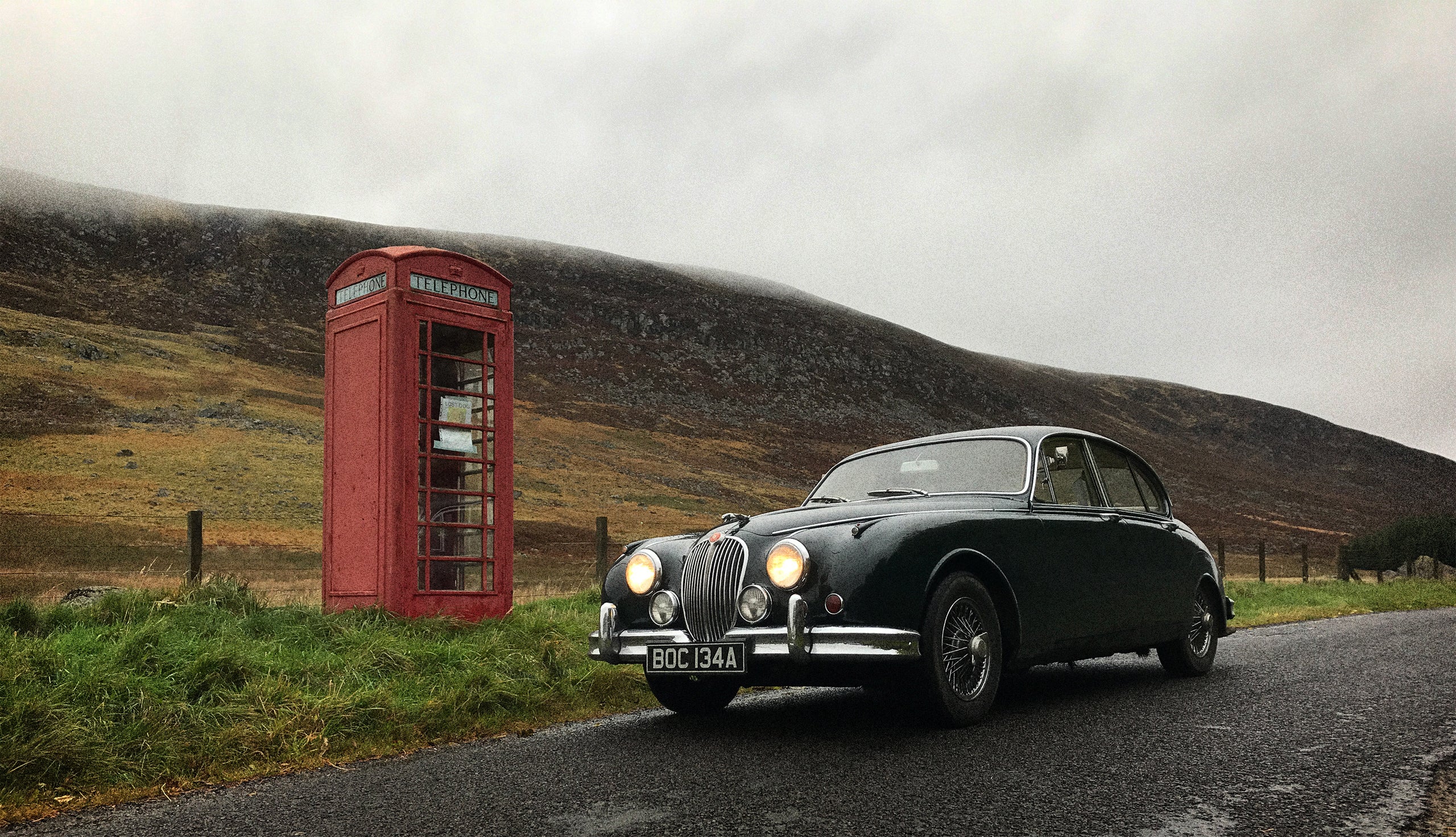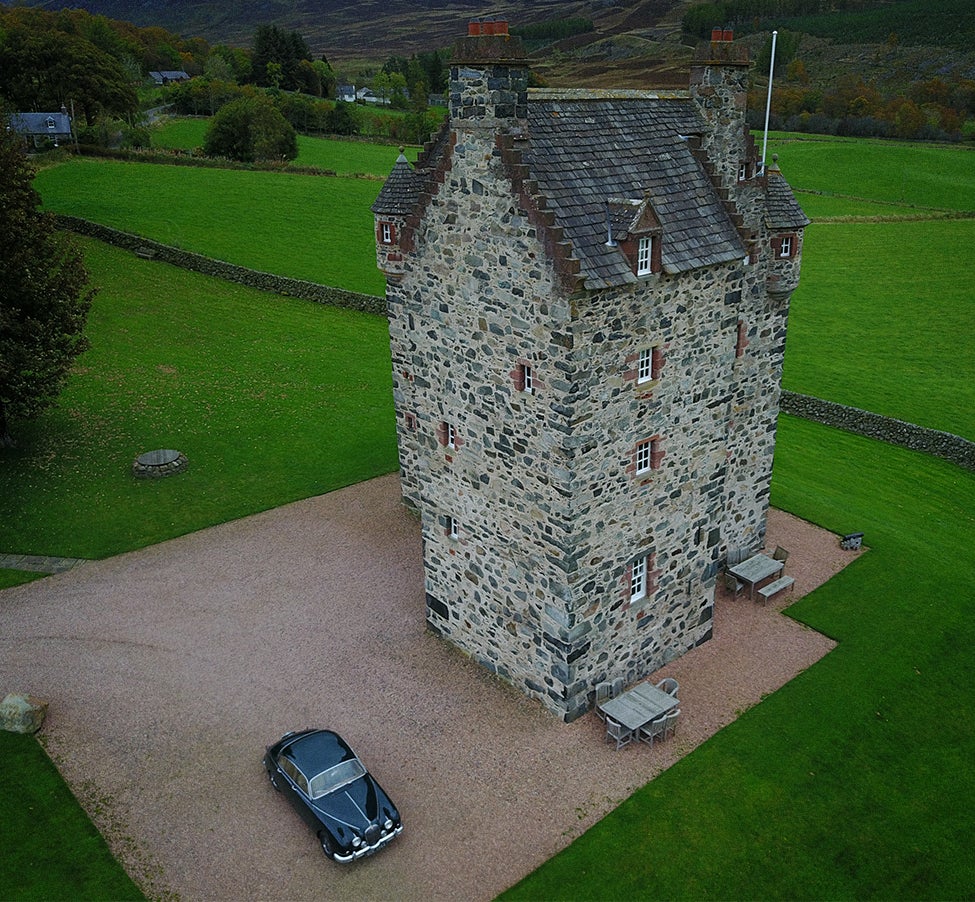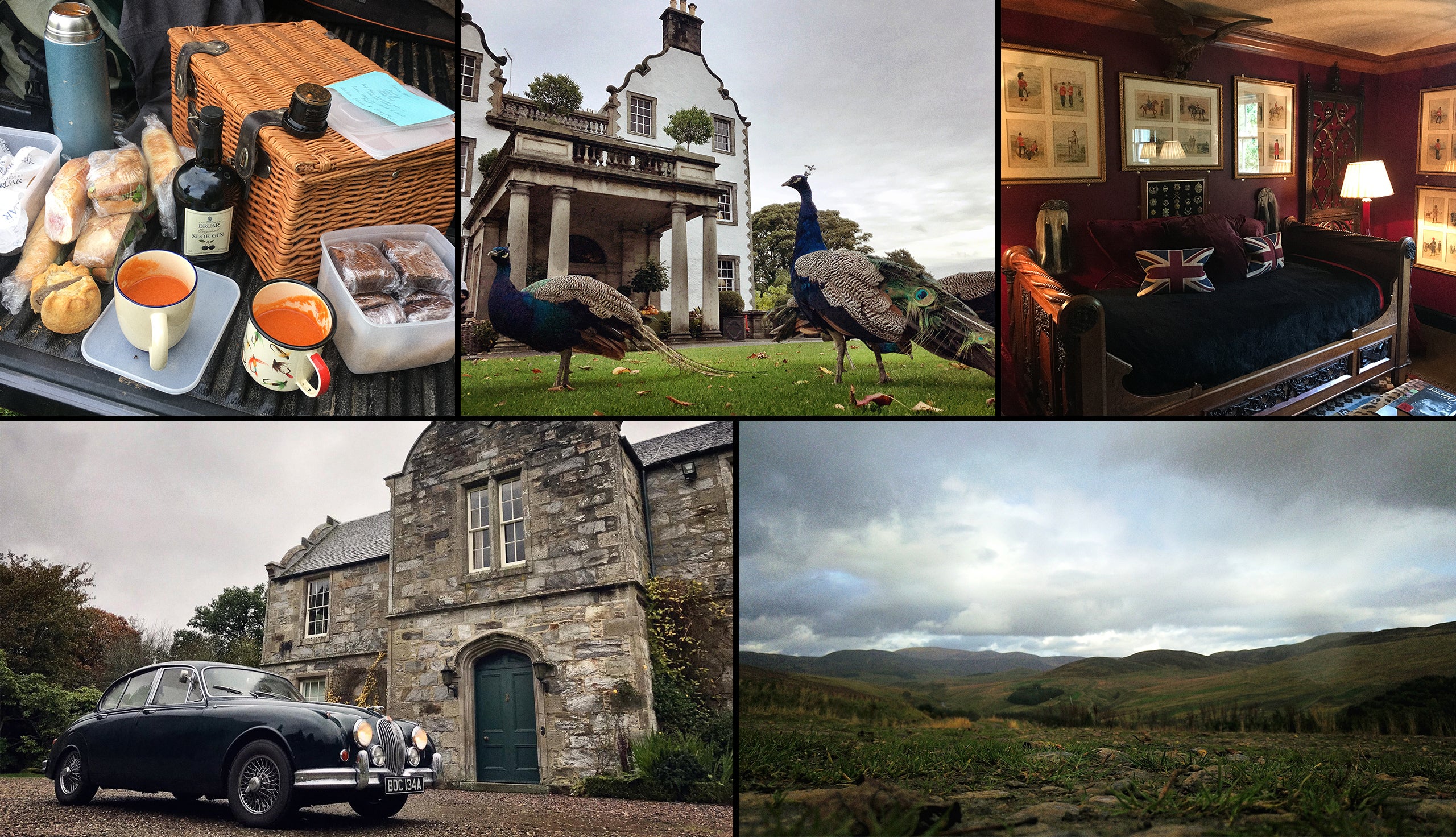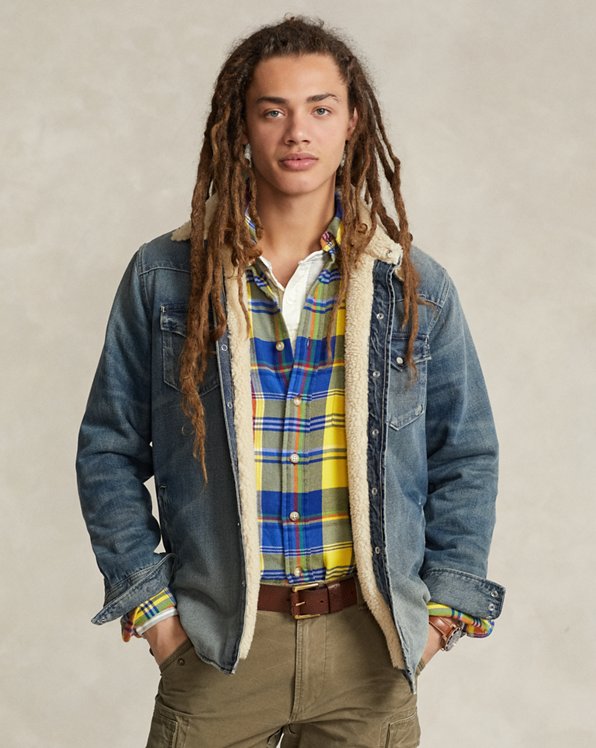
The Road
to
Glenisla
In search of salmon, single malt, and the occasional Jaguar mechanic in the Scottish Highlands
We were stranded. In front of us: the sheep-dotted peaks of the Scottish Highlands. Behind us: the 1962 MK2 Jaguar I had just driven off the road and into a ditch. My girlfriend and I were about a 45-minute drive northeast from the village of Pitlochry, in an area that is mostly farmland. Conveniently, it lacked cellphone reception.
This wasn’t the ending I expected for my Scottish sojourn, a family holiday we added to a recent visit to London. The journey began five days earlier, where our first stop was a garage in Edinburgh with an impressive array of English classics, including my aforementioned MK2. (I was tempted by an E-Type, but the bright canary yellow paint wasn’t very photogenic, and these things matter.) The car is a stunner, whose spacious boot and high-performance engine—a 3.4-liter inline six capable of hurling the car from 0 to 60 in roughly 12 seconds—helped it earn a place in history as a getaway car for heists like the Great Train Robbery of ’63. It wasn’t difficult to imagine a rakish gent in a pinstripe DB reaching across the burled walnut dash to light his cigar while flooring it into the countryside with a trunk full of cash. And somehow, I would be driving it.
Though born in Coventry, the MK2 felt at home in the Highlands, where the roads and scenery provided both a challenging drive and a dramatic backdrop for the vehicle’s British racing green coachwork. My family’s accommodations for the week would be at Forter Castle—a mid–16th-century fortress in Glenisla, originally built to protect the Balloch Pass to Glenshee. In 1640, marauders burned it to the ground. It sat in ruins for almost 400 years, until it was restored in the ’90s by a renowned English swordsmith, known for forging bespoke ceremonial weapons for the British Armed Forces.

Glenisla is about a two-hour jaunt north of Edinburgh—which itself is already far up there—a trip made extra challenging by a torrential downpour and windshield wipers that did more smearing than wiping before ultimately blowing a fuse and failing entirely. (That’s classic English wiring for you.) Still, the clouds parted as we approached the Highlands, and just in time: The roads had narrowed into a series of winding switchbacks and hairpin turns, forcing me into a constant dance with the gearshift—second, third, fourth, second, third, fourth, heel-toeing and throttling out of turn after turn.
Driving through the gates revealed a cinematic view of Forter. Inside, the fragrance of venison loin and roasted Scottish wood pigeon wafted through the halls. The stone stairway up to the Great Hall was lined with antiques, oil paintings, and hunting trophies—everything one would expect from an English castle. The hall’s focal point was a colossal roaring fireplace, with the family’s crest and swords hung above the mantel. My family and I enjoyed a candlelit dinner and a glass of scotch at a table that stretched the length of the room, with chairs trimmed in the family’s tartan. After that, a good night’s rest in a bedroom furnished with Ralph Lauren upholstery.
The next morning, a mechanic brought a spare fuse for the wipers, and my father and I drove west to the Urrard Estate. There, we spent the morning learning the Scottish art of spey fishing before a traditional partridge and pheasant hunt in the hills. Our fishing guide met us at the iron gates and took us up a mountain road through thick forest to a clearing where the House of Urrard stood—a beautiful 19th-century Georgian mansion. The only indication we were still in the 21st century: the two blacked-out Range Rovers parked in front.
After a brief meeting with the owner, we suited up in our waders, grabbed our spey fishing gear, and made our way to the River Garry. The water ran swiftly, and one misplaced step would send you down the river. Our mighty spey rods were up to the task of fighting the tough salmon—provided we had been lucky enough to hook one. Instead, we commiserated over a traditional Scottish hunting lunch of sloe gin, scotch eggs, tomato soup, and mince pies.

Afterward, our pheasant hunting guide arrived in traditional attire—tartan knee socks, ghillie brogues, and a newsboy cap. He was a stocky man with a thick accent and three unruly bird dogs. We followed him and his Defender into the heathered hills while his dogs barked in the back. At the summit, we looked out at the surrounding estates and farms, where farmers tended their herds and hunters stalked red stags. The shadows of low drifting clouds fell over the crumbling ruins of an old shepherd’s cottage while our guide readied the dogs and our guns. He handed me a beautifully engraved Holland & Holland side-by-side 12-gauge, and we journeyed through the thicket as he whistled out commands and pointed with his walking stick, directing the dogs to flush out birds. Thunder rumbled across the valley. I pulled up the collar on my tweed hunting jacket to shield me from the damp wind; my vintage knee-high leather boots provided protection against the unkempt brush and boggy terrain. Occasionally, a pheasant or partridge emerged, flying low and strong before our guns. Happily, we managed to bag a few of both before retiring for the evening.
Our next destination: Blair Athol in nearby Pitlochry. Small and quaint, with a façade overgrown with ivy turned bright red with the season, it possessed all the charm one would expect from an 18th-century distillery. In a stone barn on the property, walls of dusty oak casks sat for decades, waiting for their precious contents to reach maturity. Those that passed the Master Distiller’s stringent tests were poured into a display of tulip sampling glasses while our guide walked us through the distinct flavors of the Highlands. These drams included the house’s signature 12-year (a satisfying malty sweetness) and an exceptional 1986 whiskey we enjoyed directly from the cask. Better ways to while away an afternoon there might be, but I am unaware of them.

The tasting would have made a fine finale for the week, had fog not led me into that fateful ditch. I had fired up the Jag for one last excursion, driving my girlfriend north through Cairngorms National Park to the Glenlivet and Macallan distilleries. Thick fog and heavy dew rested on the Jaguar’s coachwork. I pulled off into the brush to allow a farm truck to pass. At that moment, the left side of the Jag sunk into the muck, and the center portion of the chassis came to rest on the asphalt. This was not good. I was wedged in an irrigation ditch previously obscured by the brush. With the wheels spinning in place and throwing mud, I spent the next few hours wedging everything from stones to logs beneath the wheels in a desperate attempt to gain traction. It was useless.
Sweaty and covered in mud, we began the 30-minute walk back to Forter in search of help. There, a neighboring sheep farmer was preparing his Defender for a day’s work in the fields and offered to lend a hand. After getting back to the Jag and throwing a heavy jute rope around the front axle, the farmer dropped his Defender into low gear and slowly inched forward until the Jag lurched back on the road. The MK2 was free—and thankfully, undamaged. I never made it to those distilleries, but I can’t say I was disappointed. At that moment, in that car, I realized I’d rather be stranded in the Scottish Highlands than motoring along anywhere else.
- Photograph by Shelby Walker
- Photographs by Maxwell Imber



































































































